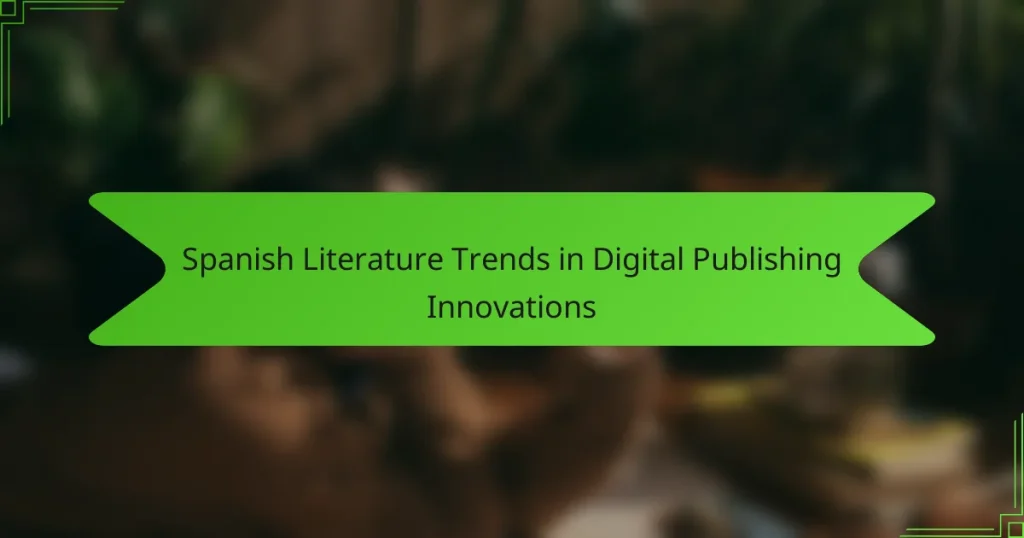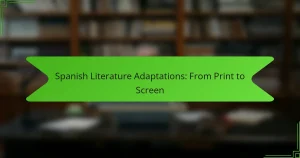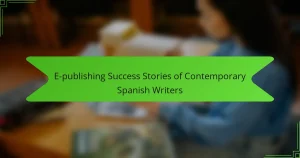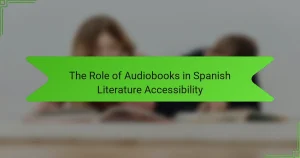Digital publishing innovations are transforming Spanish literature by enhancing accessibility and diversifying formats. Key trends include multimedia storytelling, self-publishing, and evolving reader demographics. Authors are exploring contemporary themes and utilizing social media for promotion. These changes are reshaping traditional publishing models and creating a more vibrant literary landscape.
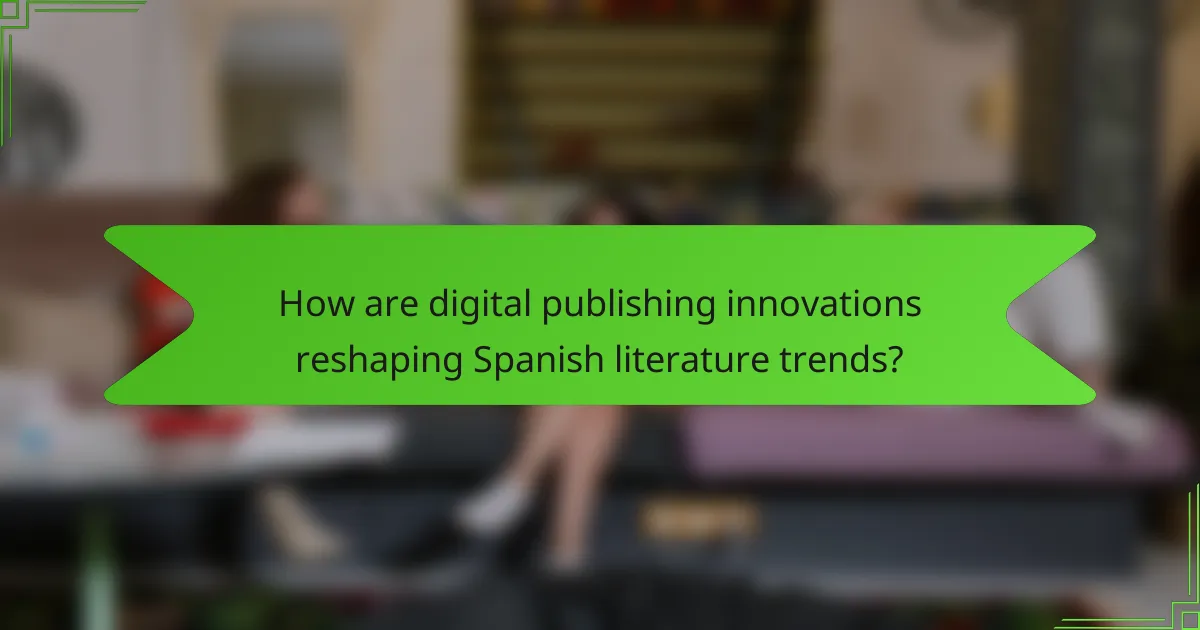
How are digital publishing innovations reshaping Spanish literature trends?
Digital publishing innovations are significantly reshaping Spanish literature trends by enhancing accessibility and diversifying formats. E-books and online platforms allow authors to reach wider audiences, while multimedia storytelling attracts new readers. Self-publishing has empowered emerging writers, resulting in a rich variety of voices and styles. As a result, traditional publishing models are evolving, leading to increased collaboration between authors and digital platforms.
What role do e-books play in the evolution of Spanish literature?
E-books significantly impact the evolution of Spanish literature by enhancing accessibility and fostering new narrative forms. They allow authors to reach broader audiences, breaking geographical barriers. Digital platforms encourage experimentation with interactive storytelling and multimedia elements, enriching the reading experience. E-books also support a diverse range of voices, including emerging writers who may lack traditional publishing opportunities. This shift towards digital formats reflects a unique attribute of modern Spanish literature, embracing innovation while preserving cultural heritage.
Which platforms are leading the way in digital publishing for Spanish authors?
Leading platforms in digital publishing for Spanish authors include Amazon Kindle Direct Publishing, Apple Books, and Google Play Books. These platforms provide extensive reach and innovative tools tailored for Spanish-speaking audiences. Amazon dominates with its vast catalog and user-friendly interface, while Apple Books emphasizes curated content and design. Google Play Books offers integration with Android devices, enhancing accessibility. Each platform supports diverse formats, enabling authors to maximize their audience engagement and revenue potential.
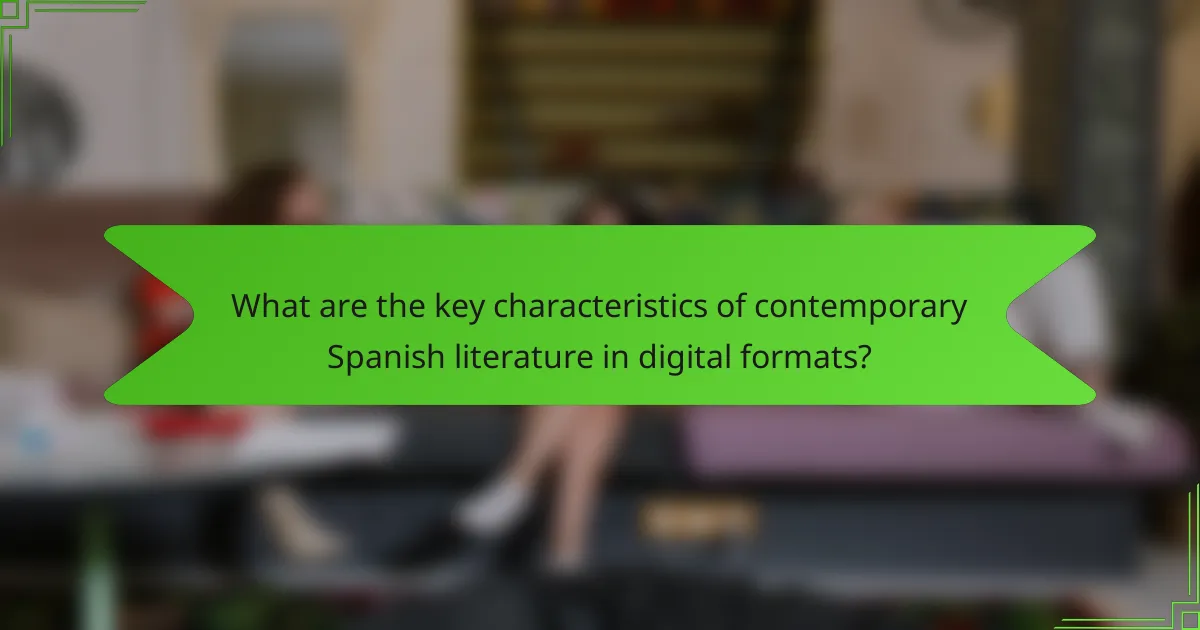
What are the key characteristics of contemporary Spanish literature in digital formats?
Contemporary Spanish literature in digital formats exhibits unique characteristics that reflect technological advancements and cultural shifts. Key trends include the integration of multimedia elements, interactive storytelling, and accessibility through various devices.
Authors increasingly explore themes of identity and globalization, often using social media platforms for promotion and engagement. Digital formats allow for innovative narrative structures, such as hypertext fiction, which enhances reader participation.
Moreover, the rise of self-publishing has democratized the literary landscape, enabling diverse voices to emerge. This shift has led to a broader representation of perspectives, enriching the overall narrative tapestry of contemporary Spanish literature.
Finally, the influence of digital reading habits is evident in shorter, serialized content that caters to modern consumption patterns, reflecting a significant departure from traditional publishing norms.
How does accessibility influence readership in Spanish-speaking regions?
Accessibility significantly enhances readership in Spanish-speaking regions by removing barriers to content. Improved access to digital platforms allows wider distribution of literature, fostering engagement. For instance, mobile-friendly formats and audiobooks cater to diverse literacy levels. As a result, readership among varied demographics increases, reflecting trends in digital publishing innovations.
What are the popular genres in Spanish digital literature today?
Popular genres in Spanish digital literature today include fiction, poetry, and essays. These genres reflect contemporary themes and innovative narrative techniques. Additionally, interactive storytelling and graphic novels are gaining traction, appealing to diverse audiences. The rise of self-publishing platforms has empowered new voices, fostering unique expressions within these genres.
How do cultural themes manifest in digital Spanish literature?
Cultural themes manifest in digital Spanish literature through innovative storytelling, diverse representation, and interactive formats. These elements reflect contemporary societal issues and regional identities. Digital platforms enable authors to explore themes like migration, identity, and technology in real-time, fostering engagement with a global audience. The unique attribute of immediacy in digital literature allows for rapid response to cultural shifts, creating a dynamic narrative landscape. As a result, readers experience literature that resonates with current cultural dialogues while embracing traditional Spanish literary elements.
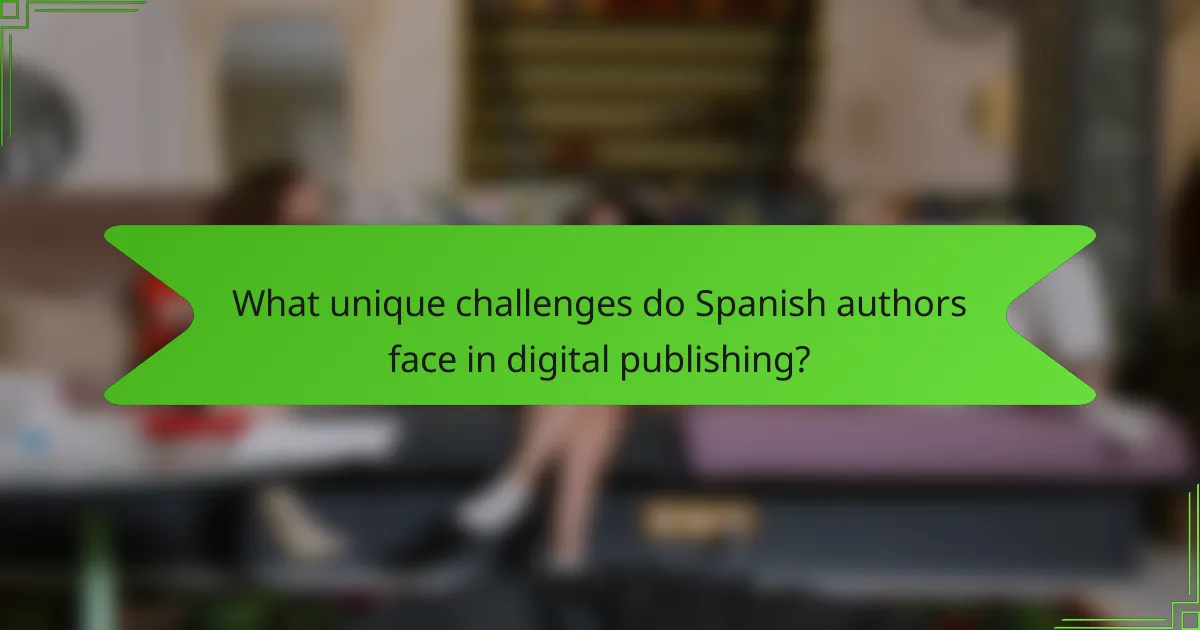
What unique challenges do Spanish authors face in digital publishing?
Spanish authors face unique challenges in digital publishing, including market saturation and visibility. The digital landscape is crowded, making it difficult for new voices to stand out. Additionally, cultural and linguistic diversity within Spain complicates audience targeting. Authors must also navigate copyright issues and the evolving dynamics of e-book pricing. Furthermore, limited access to digital marketing resources can hinder their ability to promote their work effectively. These factors collectively impact their success and reach in the digital realm.
How does copyright law affect digital publishing in Spanish-speaking countries?
Copyright law significantly influences digital publishing in Spanish-speaking countries by protecting authors’ rights and encouraging innovation. It ensures that creators can monetize their works while fostering a competitive market. For example, recent reforms in countries like Mexico and Spain have adapted copyright regulations to address digital distribution, allowing for broader access to literature. These changes promote the growth of e-books and online platforms, enhancing the reach of Spanish literature globally. As a result, authors benefit from increased royalties and greater visibility in the digital landscape.
What are the implications of self-publishing for Spanish writers?
Self-publishing offers Spanish writers greater creative control and access to global markets. It allows authors to bypass traditional publishing barriers, enabling diverse voices to emerge. Digital platforms facilitate broader distribution, making it easier for writers to reach audiences without geographical limitations. This trend reflects a shift towards personalized content and niche markets, fostering innovation in Spanish literature.
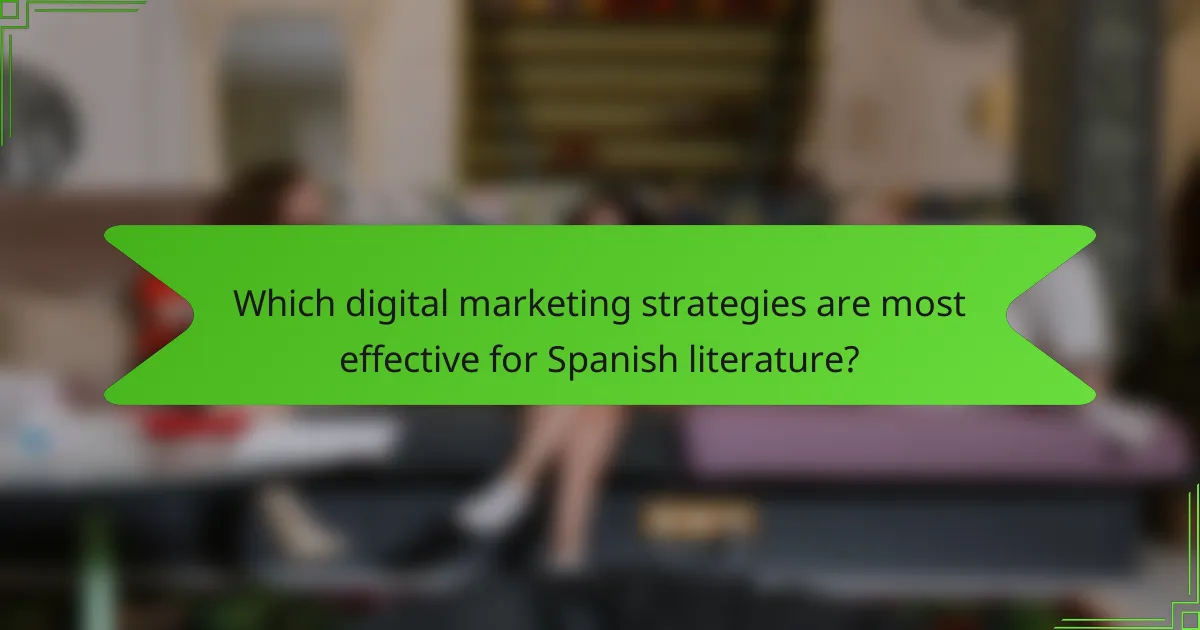
Which digital marketing strategies are most effective for Spanish literature?
Digital marketing strategies that effectively promote Spanish literature include social media engagement, influencer partnerships, and content marketing. These strategies leverage the growing interest in Spanish literature through targeted campaigns and community building.
Social media platforms like Instagram and Twitter allow authors and publishers to reach wider audiences. Engaging content such as book trailers, author interviews, and interactive posts can capture reader interest. Influencer partnerships can amplify reach, as literary influencers share recommendations to their followers, enhancing visibility.
Content marketing through blogs and newsletters provides valuable insights into Spanish literature trends. This approach establishes authority and fosters a loyal readership. Additionally, utilizing SEO techniques can improve discoverability, ensuring that content reaches those searching for Spanish literary works.
Overall, combining these strategies can create a robust digital presence for Spanish literature, driving engagement and sales.
How can social media engagement enhance visibility for Spanish authors?
Social media engagement significantly enhances visibility for Spanish authors by expanding their audience reach. Authors can connect with readers, share their work, and participate in literary discussions on various platforms.
Engagement metrics indicate that posts with high interaction rates increase discoverability. For instance, a study found that authors who actively engage on social media experience a 30% boost in follower growth. Unique content, such as live readings or Q&A sessions, fosters deeper connections with audiences.
Additionally, social media allows authors to showcase their cultural heritage and themes relevant to Spanish literature, attracting niche audiences. This visibility can lead to opportunities for collaborations and participation in literary festivals, further enhancing their presence in the digital publishing landscape.
What are the best practices for promoting e-books in Spanish markets?
To effectively promote e-books in Spanish markets, focus on targeted marketing strategies that resonate with local audiences. Utilize social media platforms popular in Spanish-speaking regions, such as Facebook and Instagram, to engage potential readers directly. Collaborate with local influencers or authors to gain credibility and reach wider audiences.
Consider leveraging email marketing campaigns tailored to Spanish-speaking demographics, highlighting unique features of the e-books such as cultural relevance or exclusive content. Additionally, optimize your website for Spanish language SEO to improve visibility in search results.
Utilizing platforms that specialize in Spanish literature can also enhance distribution. Participate in local literary events or virtual book fairs to connect with readers and showcase e-book offerings.
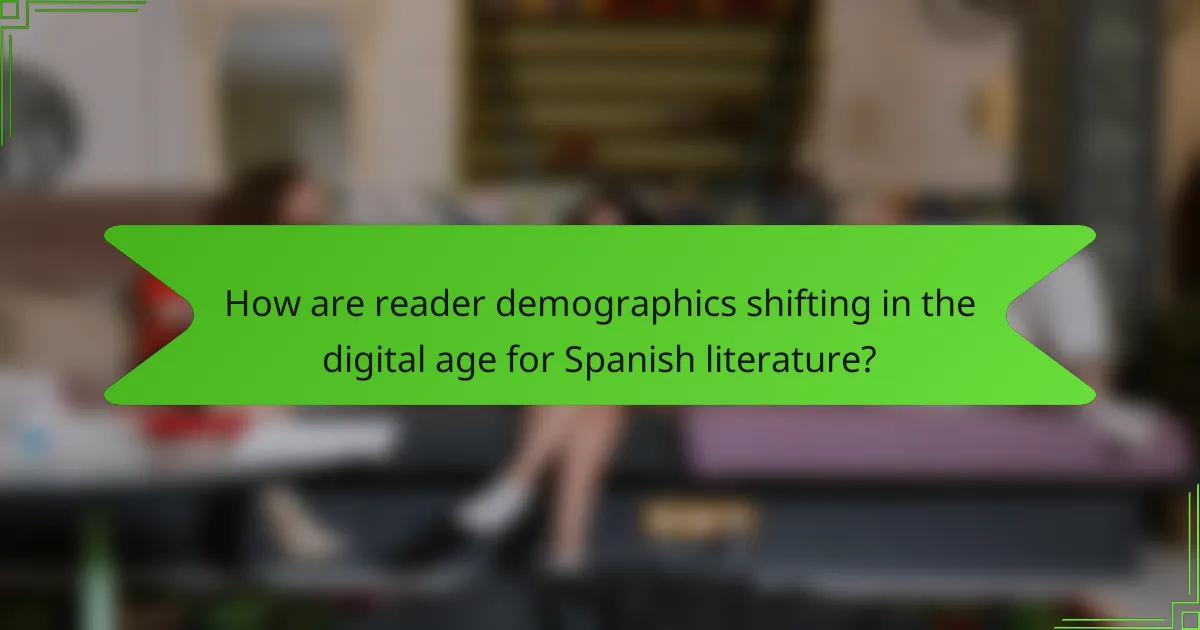
How are reader demographics shifting in the digital age for Spanish literature?
Reader demographics in Spanish literature are evolving due to digital publishing innovations. Increased access to e-books and online platforms has broadened the audience, attracting younger readers and diverse cultural backgrounds.
The rise of social media and online communities has fostered engagement, allowing authors to connect directly with readers. This shift has led to a growing interest in contemporary themes and voices that reflect modern societal issues.
Additionally, data indicates that Spanish-speaking populations in the U.S. are increasingly consuming literature digitally, representing a unique opportunity for authors and publishers. This demographic shift emphasizes the need for inclusive narratives that resonate with a wider audience.
Overall, the digital age has transformed reader demographics in Spanish literature, creating a more vibrant and diverse literary landscape.
Which age groups are most engaged with digital Spanish literature?
Young adults aged 18-34 are the most engaged with digital Spanish literature. This age group actively seeks innovative formats and themes that resonate with contemporary issues. Additionally, those aged 35-44 show a growing interest as digital platforms expand access to diverse Spanish literary works. Research indicates that digital reading trends are particularly strong among these demographics, driven by the convenience of e-books and audiobooks. As a result, publishers are increasingly targeting these age groups with tailored content and marketing strategies.
How does gender representation vary in digital Spanish literature?
Gender representation in digital Spanish literature varies significantly, reflecting broader societal changes. Women authors increasingly dominate the digital landscape, contributing diverse narratives. Studies show that female representation in Spanish digital literature rose to 40% in recent years. This shift highlights a unique attribute of digital platforms, allowing underrepresented voices to gain visibility. Additionally, themes of gender identity and feminism are prevalent, resonating with contemporary audiences. As a result, digital innovations in publishing foster a more inclusive literary environment.
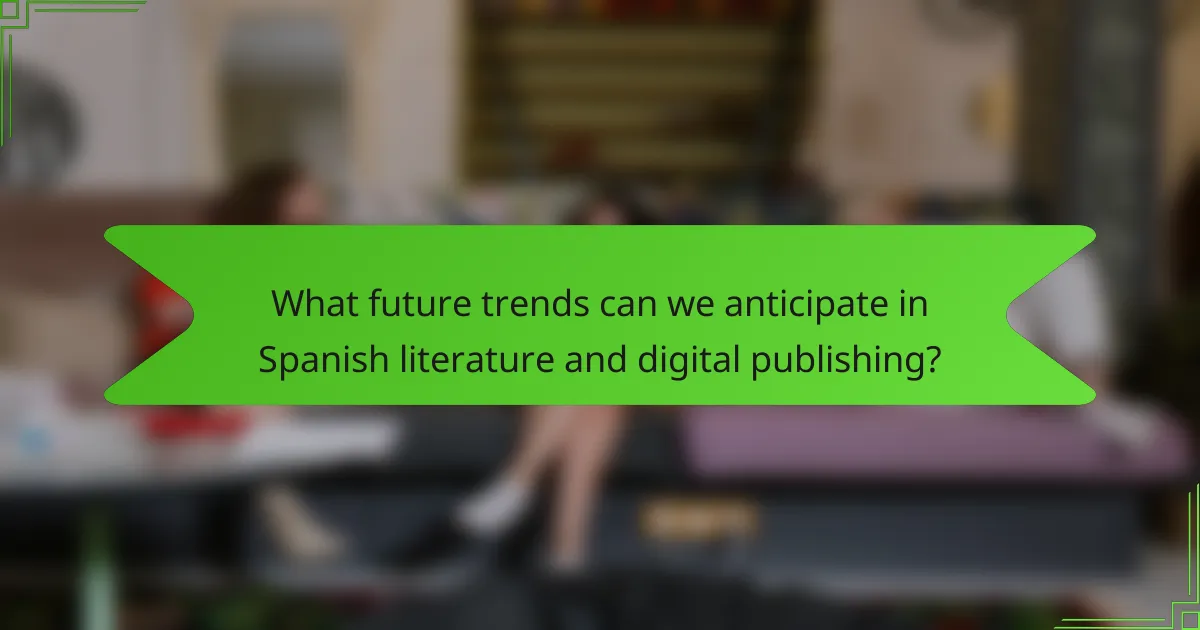
What future trends can we anticipate in Spanish literature and digital publishing?
Spanish literature will increasingly integrate digital formats, enhancing accessibility and engagement. Innovations like interactive storytelling and multimedia elements will redefine reader experiences. Additionally, the rise of self-publishing platforms empowers diverse voices, fostering a richer literary landscape. As a result, traditional publishing models may adapt to accommodate these trends, focusing on digital-first strategies.
How might technological advancements further influence Spanish literary forms?
Technological advancements are reshaping Spanish literary forms by enhancing accessibility and interactivity. Digital publishing innovations allow authors to reach wider audiences through platforms like e-books and audiobooks. These formats facilitate new storytelling techniques, such as interactive narratives that engage readers in unique ways. As a result, traditional literary boundaries are blurred, leading to hybrid genres that incorporate multimedia elements. Furthermore, data analytics can inform writers about reader preferences, influencing future works. This evolution marks a significant shift in how literature is created and consumed, fostering a dynamic literary landscape.
What emerging platforms could reshape the landscape of Spanish literature?
Emerging platforms like digital storytelling apps, social media, and e-book services are reshaping Spanish literature. These innovations enhance accessibility and engagement, allowing diverse voices to reach broader audiences. For instance, platforms such as Wattpad and Instagram have become crucial for new authors to share their work and connect with readers. Additionally, audio storytelling through podcasts and audiobooks is gaining traction, offering immersive experiences for literature lovers. As a result, these platforms foster community interaction and promote literary experimentation, driving the evolution of Spanish literature in the digital age.
What practical tips can authors follow to succeed in the digital publishing space?
Authors can succeed in the digital publishing space by embracing innovative strategies tailored to Spanish literature trends. Focus on leveraging digital platforms for wider reach, engaging with readers through social media, and utilizing data analytics to understand audience preferences. Experiment with multimedia formats, such as audiobooks and interactive e-books, to enhance storytelling. Collaborate with fellow authors and influencers to expand visibility and explore niche markets within the Spanish literary community. Establish a strong online presence through a professional website and consistent content updates to build a loyal readership.
